sensor TOYOTA RAV4 PLUG-IN HYBRID 2023 Manual PDF
[x] Cancel search | Manufacturer: TOYOTA, Model Year: 2023, Model line: RAV4 PLUG-IN HYBRID, Model: TOYOTA RAV4 PLUG-IN HYBRID 2023Pages: 718, PDF Size: 167.55 MB
Page 418 of 718
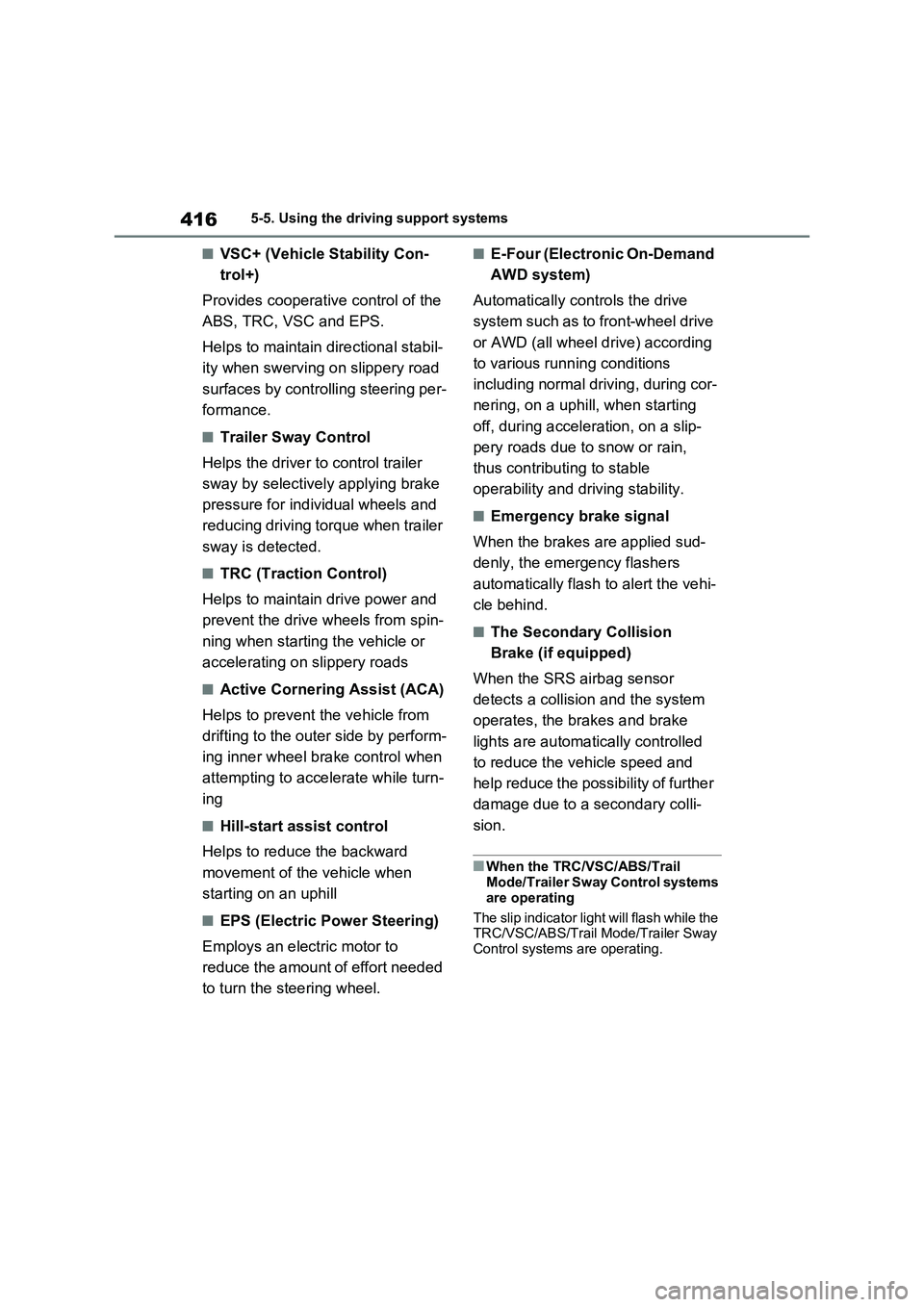
4165-5. Using the driving support systems
■VSC+ (Vehicle Stability Con-
trol+)
Provides cooperative control of the
ABS, TRC, VSC and EPS.
Helps to maintain directional stabil-
ity when swerving on slippery road
surfaces by controlling steering per-
formance.
■Trailer Sway Control
Helps the driver to control trailer
sway by selectively applying brake
pressure for individual wheels and
reducing driving torque when trailer
sway is detected.
■TRC (Traction Control)
Helps to maintain drive power and
prevent the drive wheels from spin-
ning when starting the vehicle or
accelerating on slippery roads
■Active Cornering Assist (ACA)
Helps to prevent the vehicle from
drifting to the outer side by perform-
ing inner wheel brake control when
attempting to accelerate while turn-
ing
■Hill-start assist control
Helps to reduce the backward
movement of the vehicle when
starting on an uphill
■EPS (Electric Power Steering)
Employs an electric motor to
reduce the amount of effort needed
to turn the steering wheel.
■E-Four (Electronic On-Demand
AWD system)
Automatically controls the drive
system such as to front-wheel drive
or AWD (all wheel drive) according
to various running conditions
including normal driving, during cor-
nering, on a uphill, when starting
off, during acceleration, on a slip-
pery roads due to snow or rain,
thus contributing to stable
operability and driving stability.
■Emergency brake signal
When the brakes are applied sud-
denly, the emergency flashers
automatically flash to alert the vehi-
cle behind.
■The Secondary Collision
Brake (if equipped)
When the SRS airbag sensor
detects a collision and the system
operates, the brakes and brake
lights are automatically controlled
to reduce the vehicle speed and
help reduce the possibility of further
damage due to a secondary colli-
sion.
■When the TRC/VSC/ABS/Trail
Mode/Trailer Sway Control systems
are operating
The slip indicator light will flash while the
TRC/VSC/ABS/Trail Mode/Trailer Sway
Control systems are operating.
Page 421 of 718
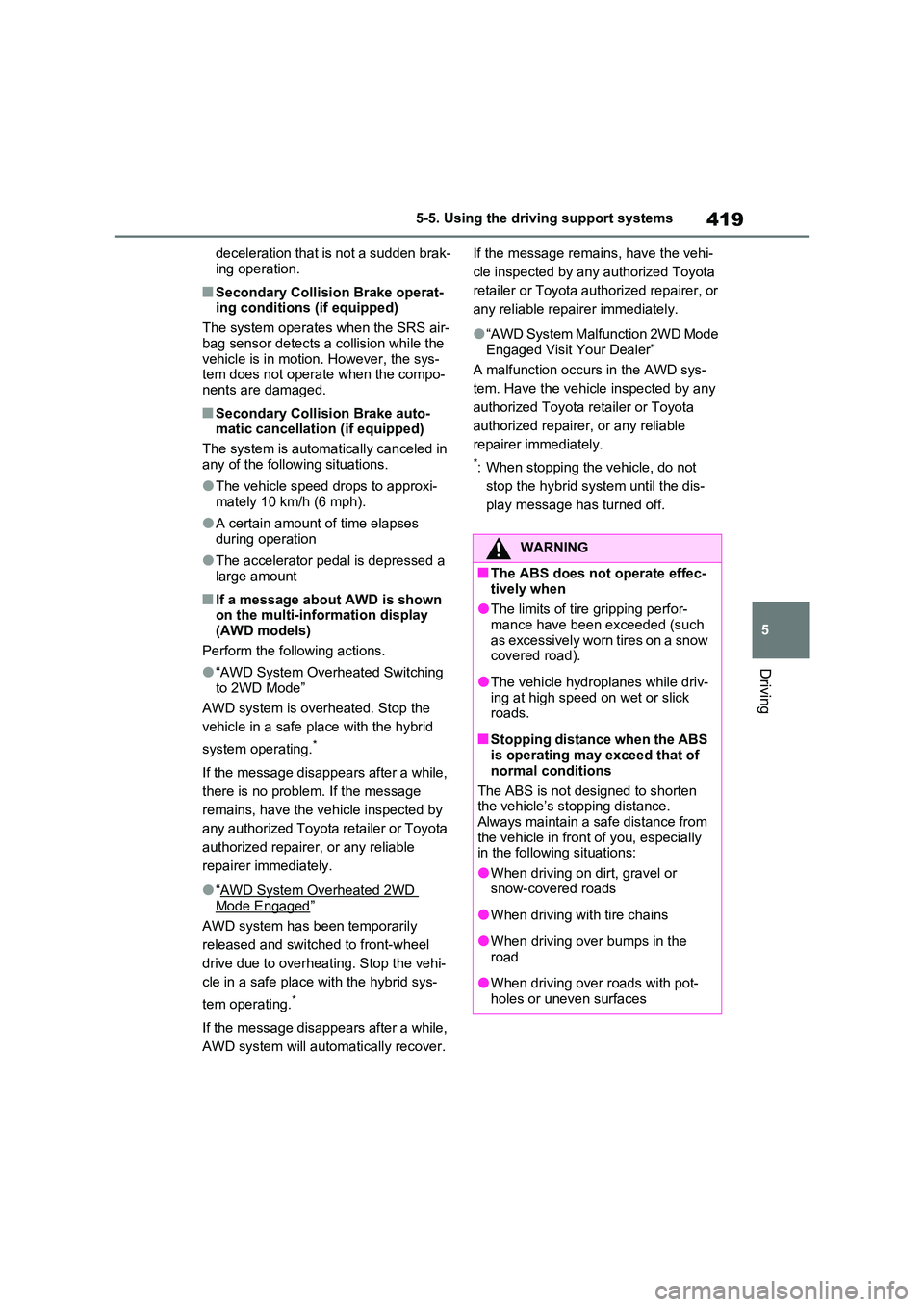
419
5
5-5. Using the driving support systems
Driving
deceleration that is not a sudden brak-
ing operation.
■Secondary Collision Brake operat- ing conditions (if equipped)
The system operates when the SRS air-
bag sensor detects a collision while the vehicle is in motion. However, the sys-tem does not operate when the compo-
nents are damaged.
■Secondary Collision Brake auto- matic cancellation (if equipped)
The system is automatically canceled in
any of the following situations.
●The vehicle speed drops to approxi-
mately 10 km/h (6 mph).
●A certain amount of time elapses
during operation
●The accelerator pedal is depressed a
large amount
■If a message about AWD is shown on the multi-information display (AWD models)
Perform the following actions.
●“AWD System Overheated Switching
to 2WD Mode”
AWD system is overheated. Stop the
vehicle in a safe place with the hybrid
system operating.*
If the message disappears after a while,
there is no problem. If the message
remains, have the vehicle inspected by
any authorized Toyota retailer or Toyota
authorized repairer, or any reliable
repairer immediately.
●“AWD System Overheated 2WD
Mode Engaged”
AWD system has been temporarily
released and switched to front-wheel
drive due to overheating. Stop the vehi-
cle in a safe place with the hybrid sys-
tem operating.*
If the message disappears after a while,
AWD system will automatically recover.
If the message remains, have the vehi-
cle inspected by any authorized Toyota
retailer or Toyota authorized repairer, or
any reliable repairer immediately.
●“AWD System Malfunction 2WD Mode Engaged Visit Your Dealer”
A malfunction occurs in the AWD sys-
tem. Have the vehicle inspected by any
authorized Toyota retailer or Toyota
authorized repairer, or any reliable
repairer immediately.
*: When stopping the vehicle, do not
stop the hybrid system until the dis-
play message has turned off.
WARNING
■The ABS does not operate effec-
tively when
●The limits of tire gripping perfor- mance have been exceeded (such
as excessively worn tires on a snow covered road).
●The vehicle hydroplanes while driv-ing at high speed on wet or slick roads.
■Stopping distance when the ABS is operating may exceed that of
normal conditions
The ABS is not designed to shorten the vehicle’s stopping distance.
Always maintain a safe distance from the vehicle in front of you, especially in the following situations:
●When driving on dirt, gravel or snow-covered roads
●When driving with tire chains
●When driving over bumps in the
road
●When driving over roads with pot-
holes or uneven surfaces
Page 437 of 718

435
6
6-1. Using the air conditioning system and defogger
Interior features
If the fan speed setting or air flow
modes are operated, the automatic
mode indicator goes off. However,
automatic mode for functions other
than that operated is maintained.
■Using automatic mode
Fan speed is adjusted automatically according to the temperature setting and the ambient conditions.
Therefore, the fan may stop for a while until warm or cool air is ready to flow immediately after the “AUTO” switch is
pressed.
■Windshield fog detection function
When automatic mode is set, the humid- ity sensor detects fog on the windshield
and controls the air conditioning system to prevent fog.
This feature is used to prevent ice
from building up on the windshield
and wiper blades.
Press the switch to turn the system
on/off.
The indicator comes on when the sys-
tem is on.
Vehicles with windshield wiper de-icer:
The windshield wiper de-icer will auto-
matically turn off after a period of time.
Vehicles with Heated Windshield
Defroster:
The Heated Windshield
Defroster will automatically turn
off in 4 minutes.
The Heated Windshield
Defroster will not operate if the
outside temperature is 5°C
(41°F) or higher.
This function automatically controls
the air conditioning airflow so that
priority is given to the front seats.
When the front passenger seat is
not occupied, airflow may switch to
only the driver’s seat. Unnecessary
air conditioning is suppressed, con-
tributing to increased fuel effi-
ciency.
Front seat concentrated airflow
mode operates in the following situ-
ations.
Windshield wiper de-icer (if
equipped)/Heated Wind-
shield Defroster (if
equipped)
WARNING
■To prevent burns
●Vehicles with windshield wiper
deicer: Do not touch the glass at lower part of the windshield or to the side of the front pillars when the
windshield wiper de-icer is on.
●Vehicles with Heated Windshield
Defroster: Do not touch the wind- shield (especially the lower part) as the surfaces can become very hot
when the Heated Windshield Defroster is on.
Front seat concentrated air-
flow mode (S-FLOW)
Page 439 of 718
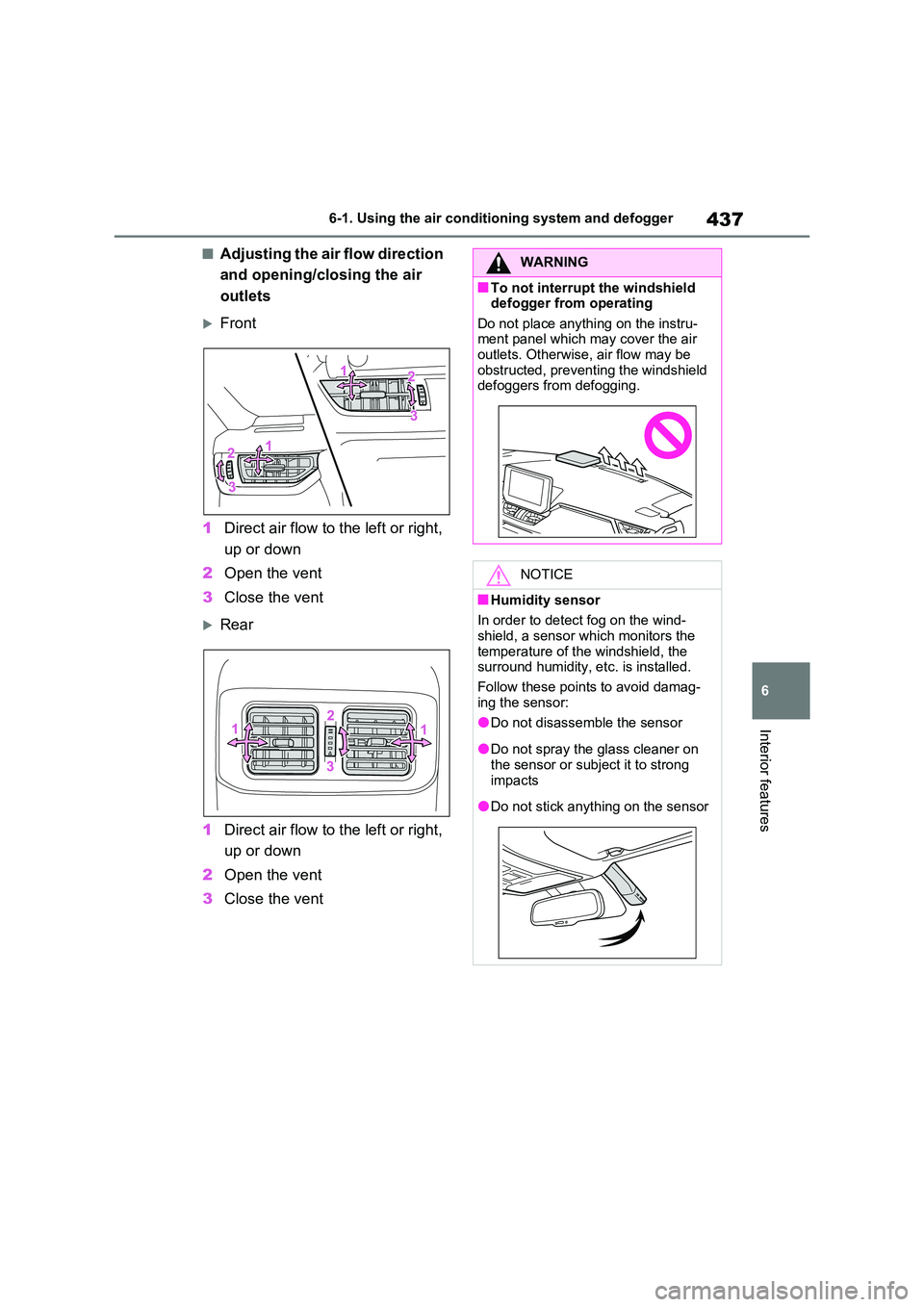
437
6
6-1. Using the air conditioning system and defogger
Interior features
■Adjusting the air flow direction
and opening/closing the air
outlets
Front
1 Direct air flow to the left or right,
up or down
2 Open the vent
3 Close the vent
Rear
1 Direct air flow to the left or right,
up or down
2 Open the vent
3 Close the vent
WARNING
■To not interrupt the windshield defogger from operating
Do not place anything on the instru- ment panel which may cover the air outlets. Otherwise, air flow may be
obstructed, preventing the windshield defoggers from defogging.
NOTICE
■Humidity sensor
In order to detect fog on the wind- shield, a sensor which monitors the
temperature of the windshield, the surround humidity, etc. is installed.
Follow these points to avoid damag-
ing the sensor:
●Do not disassemble the sensor
●Do not spray the glass cleaner on the sensor or subject it to strong
impacts
●Do not stick anything on the sensor
Page 469 of 718

467
7
7-1. Maintenance and care
Maintenance and care
■Front side windows water-repel-
lent coating (except quarter win- dow)
●The following precautions can extend the effectiveness of the water-repel-lent coating.
• Remove any dirt, etc., from the front side windows regularly.• Do not allow dirt and dust to accumu-
late on the windows for a long period. Clean the windows with a soft, damp cloth as soon as possible.
• Do not use wax or glass cleaners that contain abrasives when cleaning the windows.
• Do not use any metallic objects to remove condensation build up.
■Brake pads and calipers
Rust may form if the vehicle is parked
with wet brake pads or disc rotors, caus- ing them to stick. Before parking the vehicle after it is washed, drive slowly
and apply the brakes several times to dry the parts.
■Bumpers
Do not scrub with abrasive cleaners.
■Plated portions
If dirt cannot be removed, clean the parts as follows:
●Use a soft cloth dampened with an approximately 5% solution of neutral detergent and water to clean the dirt
off.
●Wipe the surface with a dry, soft cloth
to remove any remaining moisture.
●To remove oily deposits, use alcohol
wet wipes or a similar product.
WARNING
■When washing the vehicle
Do not apply water to the inside of the
engine compartment. Doing so may cause the electrical components, etc. to catch fire.
■When cleaning the windshield
Set the wiper switch to off. If the wiper switch is in “AUTO”, the
wipers may operate unexpectedly in the following situations, and may result in hands being caught or other
serious injuries and cause damage to the wiper blades.
Off
“AUTO”
●When the upper part of the wind-
shield where the raindrop sensor is located is touched by hand
●When a wet rag or similar is held close to the raindrop sensor
●If something bumps against the windshield
●If you directly touch the raindrop sensor body or if something bumps
into the raindrop sensor
■Precautions regarding the
exhaust pipes
Exhaust gasses cause the exhaust pipes to become quite hot.
When washing the vehicle, be careful not to touch the pipes until they have cooled sufficiently, as touching hot
exhaust pipes can cause burns.
A
B
Page 470 of 718
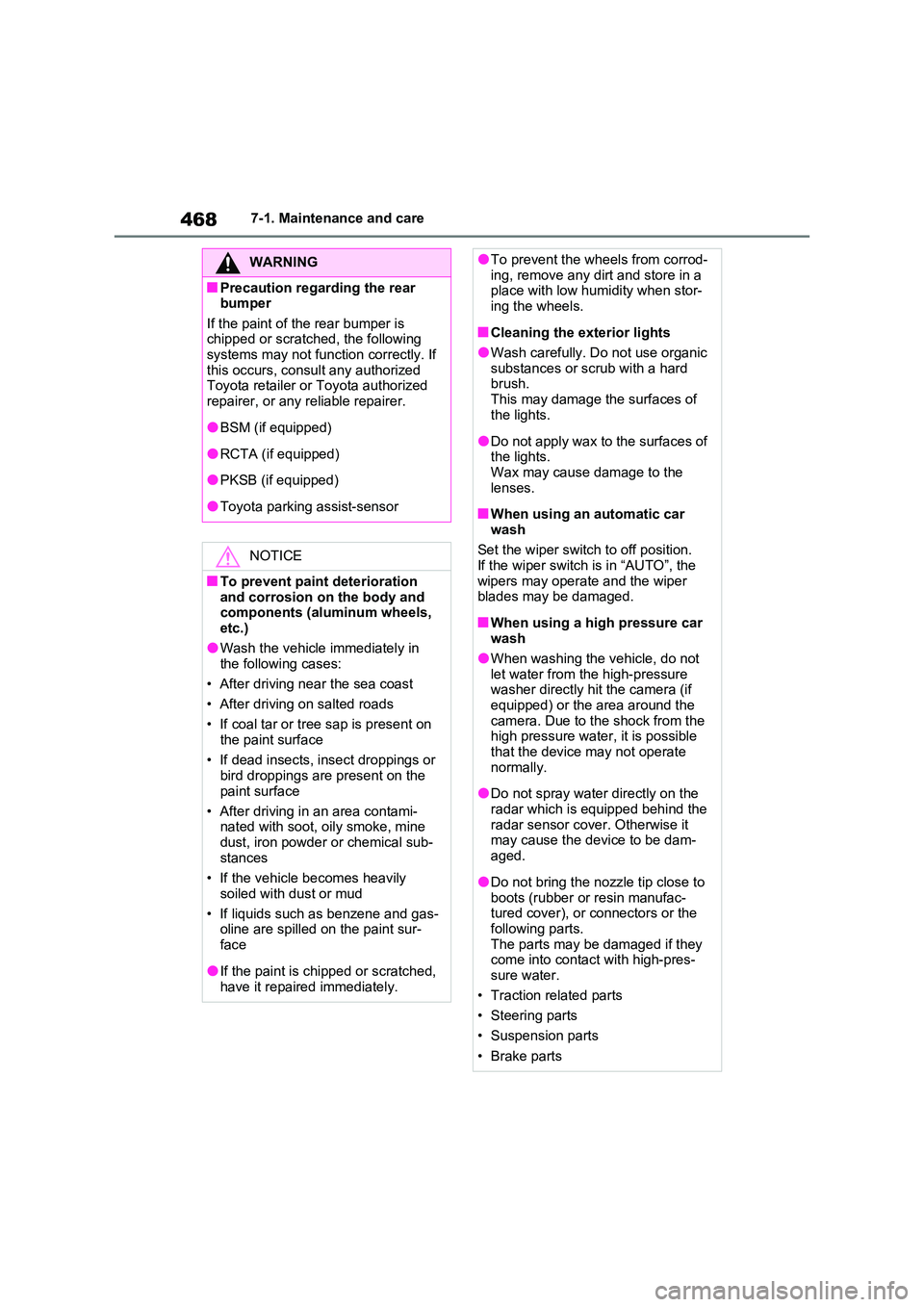
4687-1. Maintenance and care
WARNING
■Precaution regarding the rear bumper
If the paint of the rear bumper is chipped or scratched, the following systems may not function correctly. If
this occurs, consult any authorized Toyota retailer or Toyota authorized repairer, or any reliable repairer.
●BSM (if equipped)
●RCTA (if equipped)
●PKSB (if equipped)
●Toyota parking assist-sensor
NOTICE
■To prevent paint deterioration
and corrosion on the body and components (aluminum wheels, etc.)
●Wash the vehicle immediately in the following cases:
• After driving near the sea coast
• After driving on salted roads
• If coal tar or tree sap is present on
the paint surface
• If dead insects, insect droppings or bird droppings are present on the
paint surface
• After driving in an area contami- nated with soot, oily smoke, mine
dust, iron powder or chemical sub- stances
• If the vehicle becomes heavily
soiled with dust or mud
• If liquids such as benzene and gas- oline are spilled on the paint sur-
face
●If the paint is chipped or scratched,
have it repaired immediately.
●To prevent the wheels from corrod- ing, remove any dirt and store in a place with low humidity when stor-
ing the wheels.
■Cleaning the exterior lights
●Wash carefully. Do not use organic substances or scrub with a hard brush.
This may damage the surfaces of the lights.
●Do not apply wax to the surfaces of the lights.Wax may cause damage to the
lenses.
■When using an automatic car
wash
Set the wiper switch to off position. If the wiper switch is in “AUTO”, the
wipers may operate and the wiper blades may be damaged.
■When using a high pressure car wash
●When washing the vehicle, do not
let water from the high-pressure washer directly hit the camera (if equipped) or the area around the
camera. Due to the shock from the high pressure water, it is possible that the device may not operate
normally.
●Do not spray water directly on the
radar which is equipped behind the radar sensor cover. Otherwise it may cause the device to be dam-
aged.
●Do not bring the nozzle tip close to
boots (rubber or resin manufac- tured cover), or connectors or the following parts.
The parts may be damaged if they come into contact with high-pres-sure water.
• Traction related parts
• Steering parts
• Suspension parts
• Brake parts
Page 540 of 718
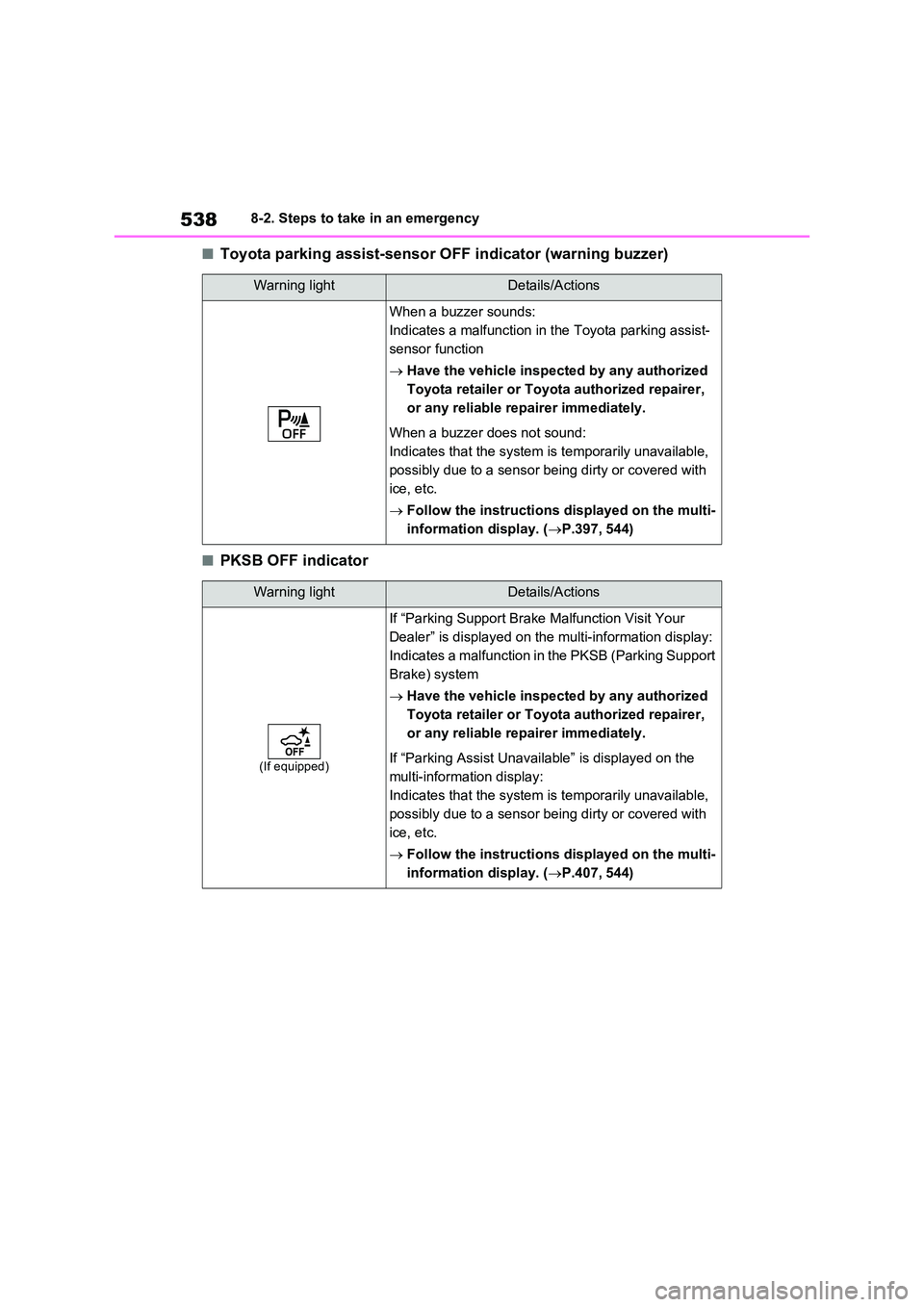
5388-2. Steps to take in an emergency
■Toyota parking assist-sensor OFF indicator (warning buzzer)
■PKSB OFF indicator
Warning lightDetails/Actions
When a buzzer sounds:
Indicates a malfunction in the Toyota parking assist-
sensor function
Have the vehicle inspected by any authorized
Toyota retailer or Toyota authorized repairer,
or any reliable repairer immediately.
When a buzzer does not sound:
Indicates that the system is temporarily unavailable,
possibly due to a sensor being dirty or covered with
ice, etc.
Follow the instructions displayed on the multi-
information display. ( P.397, 544)
Warning lightDetails/Actions
(If equipped)
If “Parking Support Brake Malfunction Visit Your
Dealer” is displayed on the multi-information display:
Indicates a malfunction in the PKSB (Parking Support
Brake) system
Have the vehicle inspected by any authorized
Toyota retailer or Toyota authorized repairer,
or any reliable repairer immediately.
If “Parking Assist Unavailable” is displayed on the
multi-information display:
Indicates that the system is temporarily unavailable,
possibly due to a sensor being dirty or covered with
ice, etc.
Follow the instructions displayed on the multi-
information display. ( P.407, 544)
Page 544 of 718
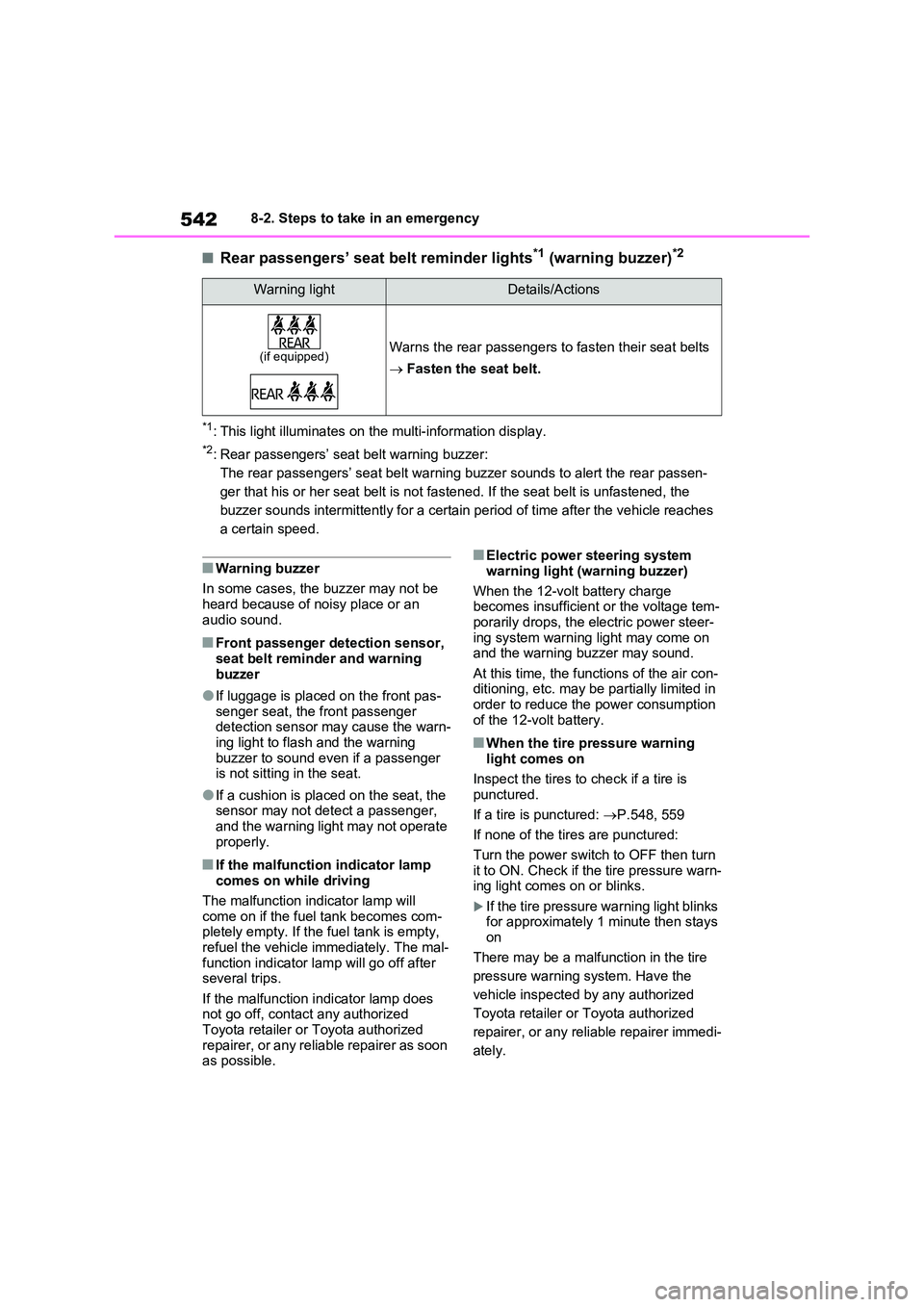
5428-2. Steps to take in an emergency
■Rear passengers’ seat belt reminder lights*1 (warning buzzer)*2
*1: This light illuminates on the multi-information display.
*2: Rear passengers’ seat belt warning buzzer:
The rear passengers’ seat belt warning buzzer sounds to alert the rear passen-
ger that his or her seat belt is not fastened. If the seat belt is unfastened, the
buzzer sounds intermittently for a certain period of time after the vehicle reaches
a certain speed.
■Warning buzzer
In some cases, the buzzer may not be
heard because of noisy place or an audio sound.
■Front passenger detection sensor, seat belt reminder and warning
buzzer
●If luggage is placed on the front pas-
senger seat, the front passenger detection sensor may cause the warn-ing light to flash and the warning
buzzer to sound even if a passenger is not sitting in the seat.
●If a cushion is placed on the seat, the sensor may not detect a passenger,
and the warning light may not operate properly.
■If the malfunction indicator lamp comes on while driving
The malfunction indicator lamp will come on if the fuel tank becomes com-pletely empty. If the fuel tank is empty,
refuel the vehicle immediately. The mal- function indicator lamp will go off after several trips.
If the malfunction indicator lamp does not go off, contact any authorized Toyota retailer or Toyota authorized
repairer, or any reliable repairer as soon as possible.
■Electric power steering system
warning light (warning buzzer)
When the 12-volt battery charge becomes insufficient or the voltage tem-
porarily drops, the electric power steer- ing system warning light may come on and the warning buzzer may sound.
At this time, the functions of the air con- ditioning, etc. may be partially limited in order to reduce the power consumption
of the 12-volt battery.
■When the tire pressure warning light comes on
Inspect the tires to check if a tire is
punctured.
If a tire is punctured: P.548, 559
If none of the tires are punctured:
Turn the power switch to OFF then turn it to ON. Check if the tire pressure warn-ing light comes on or blinks.
If the tire pressure warning light blinks for approximately 1 minute then stays on
There may be a malfunction in the tire
pressure warning system. Have the
vehicle inspected by any authorized
Toyota retailer or Toyota authorized
repairer, or any reliable repairer immedi-
ately.
Warning lightDetails/Actions
(if equipped)Warns the rear passengers to fasten their seat belts
Fasten the seat belt.
Page 549 of 718
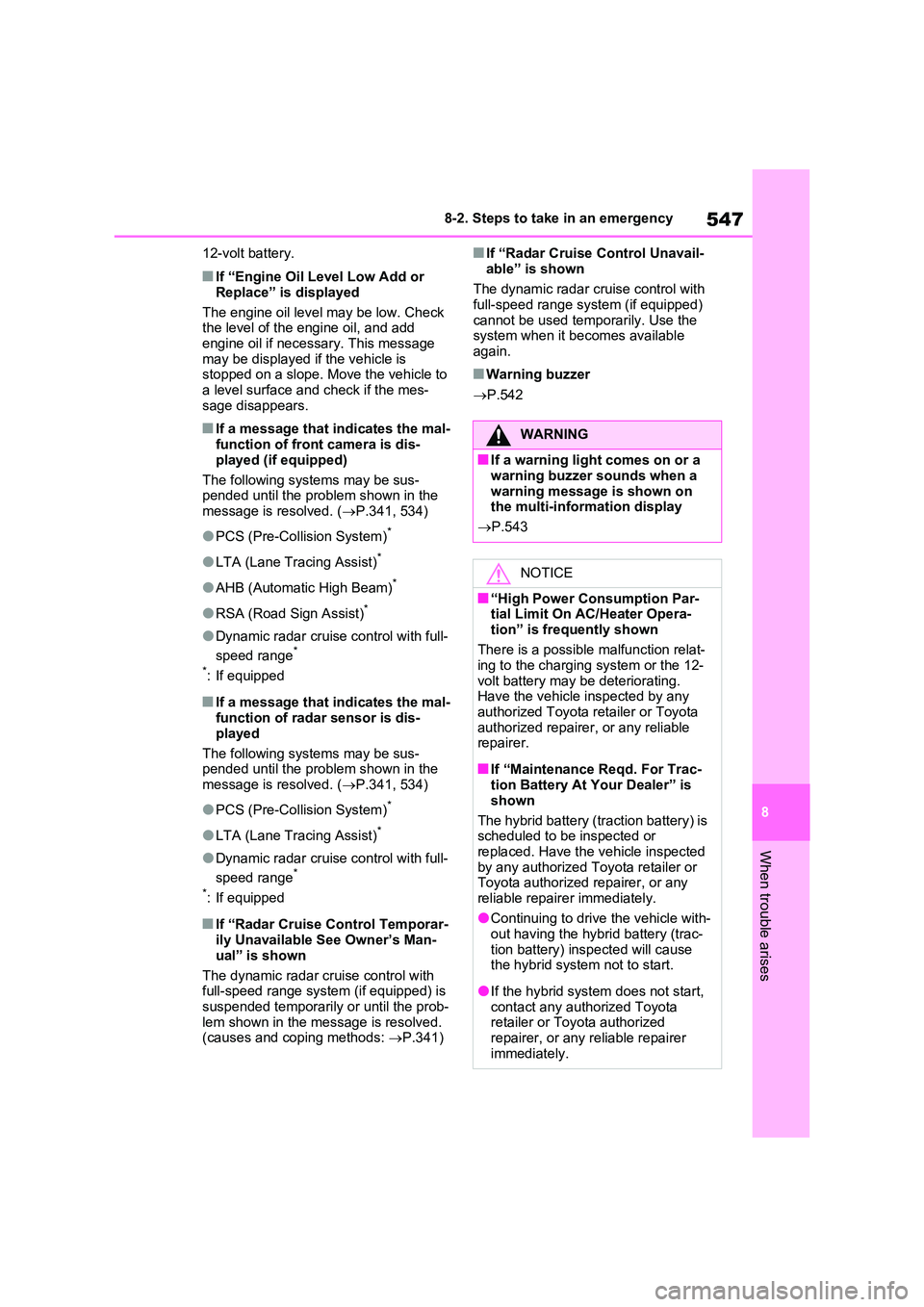
547
8
8-2. Steps to take in an emergency
When trouble arises
12-volt battery.
■If “Engine Oil Level Low Add or
Replace” is displayed
The engine oil level may be low. Check the level of the engine oil, and add
engine oil if necessary. This message may be displayed if the vehicle is stopped on a slope. Move the vehicle to
a level surface and check if the mes- sage disappears.
■If a message that indicates the mal-function of front camera is dis-
played (if equipped)
The following systems may be sus- pended until the problem shown in the
message is resolved. ( P.341, 534)
●PCS (Pre-Collision System)*
●LTA (Lane Tracing Assist)*
●AHB (Automatic High Beam)*
●RSA (Road Sign Assist)*
●Dynamic radar cruise control with full-
speed range*
*: If equipped
■If a message that indicates the mal- function of radar sensor is dis-
played
The following systems may be sus- pended until the problem shown in the
message is resolved. ( P.341, 534)
●PCS (Pre-Collision System)*
●LTA (Lane Tracing Assist)*
●Dynamic radar cruise control with full-
speed range*
*: If equipped
■If “Radar Cruise Control Temporar- ily Unavailable See Owner’s Man-
ual” is shown
The dynamic radar cruise control with full-speed range system (if equipped) is
suspended temporarily or until the prob- lem shown in the message is resolved. (causes and coping methods: P.341)
■If “Radar Cruise Control Unavail-
able” is shown
The dynamic radar cruise control with full-speed range system (if equipped)
cannot be used temporarily. Use the system when it becomes available again.
■Warning buzzer
P.542
WARNING
■If a warning light comes on or a warning buzzer sounds when a
warning message is shown on the multi-information display
P.543
NOTICE
■“High Power Consumption Par- tial Limit On AC/Heater Opera-
tion” is frequently shown
There is a possible malfunction relat- ing to the charging system or the 12-
volt battery may be deteriorating. Have the vehicle inspected by any
authorized Toyota retailer or Toyota authorized repairer, or any reliable repairer.
■If “Maintenance Reqd. For Trac-tion Battery At Your Dealer” is
shown
The hybrid battery (traction battery) is scheduled to be inspected or
replaced. Have the vehicle inspected by any authorized Toyota retailer or Toyota authorized repairer, or any
reliable repairer immediately.
●Continuing to drive the vehicle with- out having the hybrid battery (trac-
tion battery) inspected will cause the hybrid system not to start.
●If the hybrid system does not start, contact any authorized Toyota retailer or Toyota authorized
repairer, or any reliable repairer immediately.
Page 550 of 718
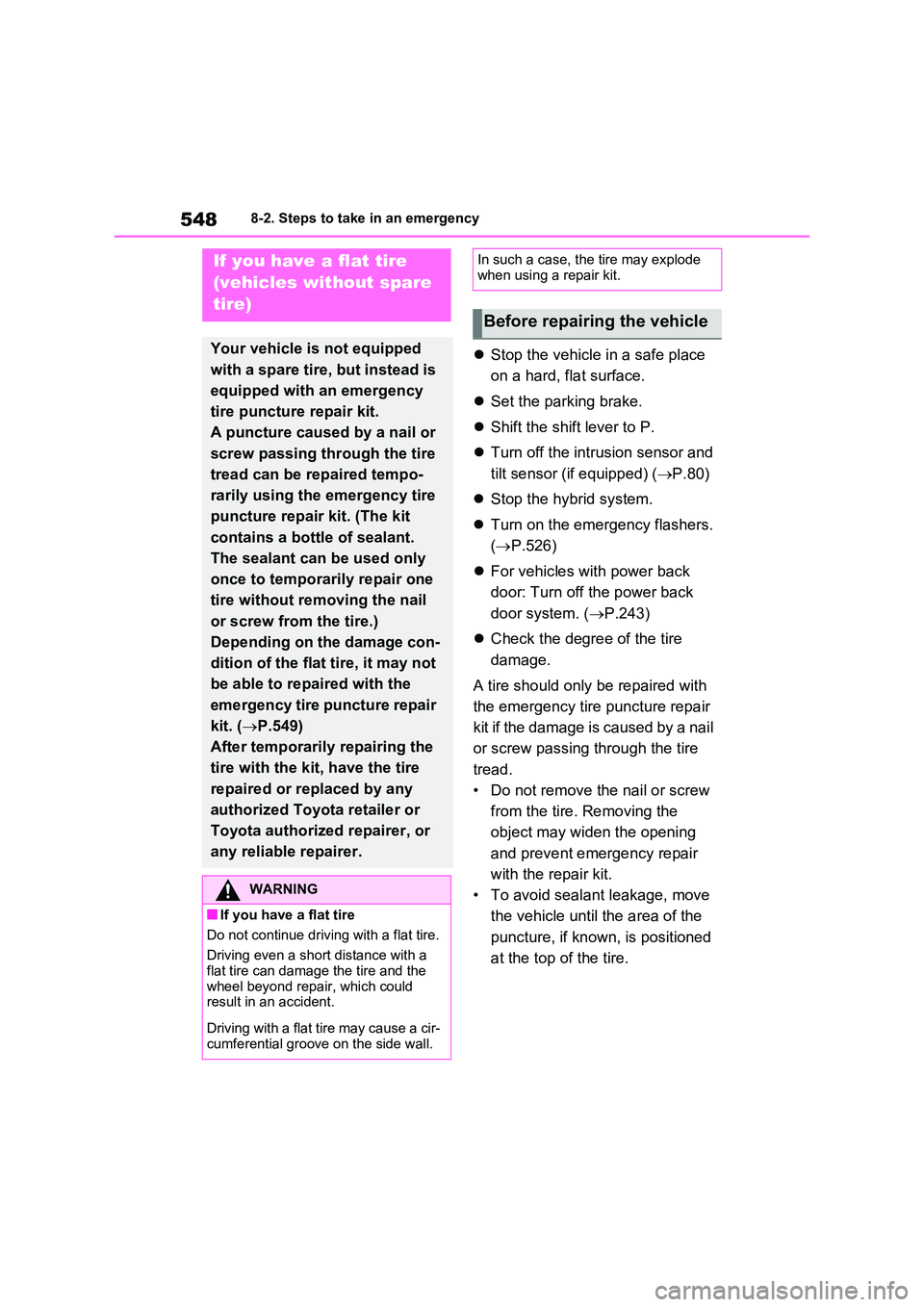
5488-2. Steps to take in an emergency
Stop the vehicle in a safe place
on a hard, flat surface.
Set the parking brake.
Shift the shift lever to P.
Turn off the intrusion sensor and
tilt sensor (if equipped) ( P.80)
Stop the hybrid system.
Turn on the emergency flashers.
( P.526)
For vehicles with power back
door: Turn off the power back
door system. ( P.243)
Check the degree of the tire
damage.
A tire should only be repaired with
the emergency tire puncture repair
kit if the damage is caused by a nail
or screw passing through the tire
tread.
• Do not remove the nail or screw
from the tire. Removing the
object may widen the opening
and prevent emergency repair
with the repair kit.
• To avoid sealant leakage, move
the vehicle until the area of the
puncture, if known, is positioned
at the top of the tire.
If you have a flat tire
(vehicles without spare
tire)
Your vehicle is not equipped
with a spare tire, but instead is
equipped with an emergency
tire puncture repair kit.
A puncture caused by a nail or
screw passing through the tire
tread can be repaired tempo-
rarily using the emergency tire
puncture repair kit. (The kit
contains a bottle of sealant.
The sealant can be used only
once to temporarily repair one
tire without removing the nail
or screw from the tire.)
Depending on the damage con-
dition of the flat tire, it may not
be able to repaired with the
emergency tire puncture repair
kit. ( P.549)
After temporarily repairing the
tire with the kit, have the tire
repaired or replaced by any
authorized Toyota retailer or
Toyota authorized repairer, or
any reliable repairer.
WARNING
■If you have a flat tire
Do not continue driving with a flat tire.
Driving even a short distance with a
flat tire can damage the tire and the wheel beyond repair, which could result in an accident.
Driving with a flat tire may cause a cir- cumferential groove on the side wall.
In such a case, the tire may explode when using a repair kit.
Before repairing the vehicle